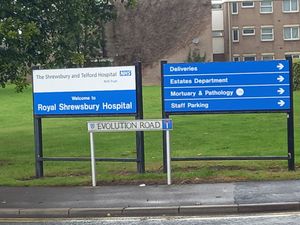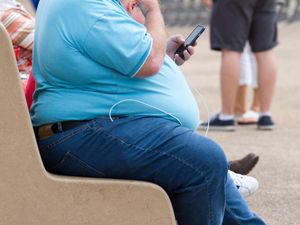'Erosion of care and dignity': Exposé to reveal 'suffering and indignity' at Shropshire hospital A&E
Patients at a Shropshire hospital are facing "suffering and indignity" on a daily basis, an undercover TV investigation claims.
Watch more of our videos on ShotsTV.com
and on Freeview 262 or Freely 565
Channel 4 Dispatches went undercover in the emergency department of the Royal Shrewsbury Hospital and is set to expose the human impact of the crisis in the NHS in a programme tonight.
Over the last two months, a Dispatches reporter has filmed secretly while working as a trainee healthcare assistant inside the emergency department of the Royal Shrewsbury Hospital.
The broadcaster said the footage obtained by the reporter exposes the suffering and indignity faced by patients on a daily basis.
This includes footage of one elderly gentleman being forced to urinate in a trolley on the corridor in full view of staff and other patients. On another shift, a female patient is left crying out in agony for hours.
Other revelations include a makeshift ward set up on the X-ray corridor which is isolated from doctors and nurses and which has no sinks and insufficient plug sockets.
The documentary also shows patients being forced to wait up for up to four and a half hours in ambulance queues, while some ambulance crews who cannot wait drop their patients in the “ambulance reception area” without a proper handover.
In the episode, patients are seen waiting in the emergency department for up to 46 hours.
When asked to comment on the documentary, a spokesperson for the trust that runs the hospital said in a statement: "We are very sorry that our patients have experienced anything less than the quality care we strive for, and we are determined, working with partners, to improve the care and experience for everyone."
Only last Tuesday, June 18, the Shrewsbury and Telford Hospital NHS Trust (SaTH) declared a “critical incident” as it was overwhelmed. A message reportedly sent to staff - seen by Dispatches - warned that urgent and emergency care services were under “significant pressure” due to “high demand".
A Freedom of Information request by Dispatches to NHS England found almost 400,000 patients were waiting in A&E for more than 24 hours in the 12 months from April 2023 to March 2024, a 5 per cent rise on the same period last year.
This included 54,000 who spent more than 48 hours in A&E and almost 19,000 who were there for 72 hours.
Dr Adrian Boyle, president of the Royal College of Emergency Medicine, says in the Dispatches programme: “I don’t think this is unique to this hospital by any stretch of the imagination. The things we've seen here today are clearly not just confined to winter. It was a year-round crisis in emergency care.
“Spending two days in an emergency department is, you know, it's worse than spending two days in an airport lounge. These are people who are sitting in uncomfortable seats where the lights never go off.
"There’s constant noise, there’s constant stress. There's no end in sight. People will miss their routine medications. They'll be next to people who can infect them with other diseases. You know, it's just not acceptable.”
Siva Anandaciva, chief analyst at the health and social care charity the Kings Fund, said: “That could be any one of a number of hospitals up and down the country, which is absolutely staggering.
“I think the standard of A&E care in England is in about as deep a hole as I've seen in the last 20 years. So whatever government comes in, they have a huge task to recover performance.
“However bad you think it is, how bad the stats are - it’s worse. You have got people dying in A&E departments in England in 2024 that don't need to be dying.”
Professor Alf Collins, trustee of the Patients Association and former NHS England Clinical Director for personalised care, said: “It's dreadful. People waiting just far, far too long.
“It’s almost becoming acceptable now. It's almost becoming the standard of care that people expect.
“Sad to say. I don't think this is exceptional.”
Claims
Desperately long waits and 'fit to sit'
The footage shows the Shrewsbury hospital's A&E has installed a “Fit to Sit” area where patients who need to see a specialist doctor or who require tests or scans sit for hours on hard chairs.
A growing number of hospitals across England have introduced similar policies to try and reduce ambulance handover times and limit the number of patients taking up trolleys.
However many of these patients are frail and very unwell. The documentary footage shows the reporter talking to an elderly couple who have been waiting in A&E for 30 hours.
A woman with a suspected stroke has waited there for over 24 hours. Even the staff are appalled, and a nurse is overheard saying: “29 hours in Fit to Sit before anything’s happened for her. That’s disgusting care.”
Across the emergency department, patients wait far longer than the four-hour target to be discharged, transferred or admitted onto a ward. The reporter is seen reading the numbers off the computer screen of patients who have been in A&E for 35, 40 and 46 hours.
Responding to footage of these long waits, Professor Collins said: “It's dreadful. People waiting just far, far too long.
“It’s almost becoming acceptable now. It's almost becoming the standard of care that people expect. Sad to say. I don't think this is exceptional.”
The X-ray corridor ward
Due to the levels of overcrowding, staff have set up a semi-permanent ward on the X-ray corridor which has five trolleys.
But as the corridor has been blocked off, it is isolated from doctors and nurses on the rest of the emergency department. There are no sinks to wash hands and insufficient plug sockets for machines.
After just five shifts – and ten days’ classroom training – the reporter is asked to help out a nurse on that ward.
At one point he is left alone with five ill patients for 20 minutes, including a woman who is screaming in agony. The reporter is heard saying: “I could literally cry.”
Referring to the woman in pain, Professor Collins said: “It's dreadful. It is clearly unacceptable. It's a basic requirement, isn’t it, that if we go into A&E and we’re in pain it would be really good to have our pain managed? That's an example that the quality of care is really massively eroded.”
'Erosion of care and dignity'
One scene shows a senior nurse reading out a list of serious complaints at the morning handover meeting. She tells the gathered staff that “basic nursing care standards have fallen significantly”.
Her list of shortcomings sum up some of the problems facing the emergency department and they include: “Patients on oxygen have not been monitored appropriately…patients being left in a state of partial undress and no urgency from staff to address the issue... patients being left on bedpans for too long... end-of-life patients not having appropriate observations.”
One of the issues which most shocks the reporter is the lack of dignity offered to these patients in these overcrowded conditions. In one scene he helps an elderly man go to the toilet in a bottle in full view of the patients and staff on the ward.
The reporter is heard to say: "We've got people having to go to the toilet in public in the corridor. It’s not OK. If that was my family member, I’d be fuming.”
Professor Collins said: “How can you not be moved by witnessing that, that man in enormous distress, profoundly ill? Having (to) pass urine in a corridor. The very most basic standard of care that we should be delivering is not being delivered.
“It's clearly unacceptable that people should be cared for in corridors, clearly unacceptable.”
Ambulance patients dropped off without a proper handover
According to the film, some ambulance crews leave their patients in the crowded Ambulance Receiving Area without giving staff a proper handover, as they rush to respond to the next call.
The practice is known in the department as “drop and go” and several staff are concerned that it is dangerous. One nurse is heard to say: “It’s full all the time. They just put them anywhere. It’s really unsafe.”
The reporter speaks to other patients who have been in the back of ambulances outside the emergency department for two, three and four and a half hours.
Dr Sanjeev Nayak, a consultant interventional neuroradiologist and stroke specialist who is interviewed for the Dispatches episode, underlined the dangers of ‘drop and go’ and said: “It impacts patient safety. If somebody's being dropped off without a proper handover then it's a real concern.
“It’s not just a breach of protocol, it’s negligence.”
Response
When asked to comment, a spokesperson for SaTH said: “As with other hospitals, our trust is facing significant challenges with urgent and emergency care. We understand our challenges and are investing in our services and making steady improvements as a trust, as noted in our recent CQC report.
"However, there is still much more to do; we do not want to be in a position where we are caring for patients on corridors. We are very sorry that our patients have experienced anything less than the quality care we strive for, and we are determined, working with partners, to improve the care and experience for everyone. Our colleagues are working incredibly hard to maintain safe services and we are grateful for everything they are doing to support our patients in this difficult working environment.
“Whilst we dispute some of the claims made in the Dispatches programme, we will fully investigate all of the claims to identify and embed any learning into our continuous improvement work. We remain committed to being open and transparent with our patients and staff and encourage anyone with concerns to contact our PALS team.”
Professor Julian Redhead, NHS England's national clinical director for urgent and emergency care, said: “What has been observed in Shrewsbury and Telford Hospital NHS Trust in recent weeks is not commonplace in A&Es across the country, and is not acceptable, and we are continuing to offer the trust the highest level of national support to improve care for patients.
"While the health service is facing significant demand for services, with more people attending A&Es in England in May than any other month on record and attendances and emergency admissions up almost 20 per cent on a decade ago, the NHS has a detailed plan to overhaul urgent care services, including offering greater use of same day emergency care and urgent community response teams, and by delivering an extra 5,000 core beds in hospitals.
“Thanks to these measures and the dedication of NHS staff, latest data shows 20 per cent more patients were seen in A&Es within four hours in May compared with the same month last year – and the NHS will continue to work closely with the most challenged trusts and colleagues in local authorities to help speed up discharge and free up beds for those who need them most."
The episode, Undercover A&E: NHS in Crisis – Dispatches will be broadcast on Monday, June 24 at 9pm on Channel 4.
Following the episode, Krishnan Guru-Murthy will host a special one-off debate: NHS in Crisis? The Debate - examining the political parties' plans for the NHS and including testimony from those who work in and use the service.





